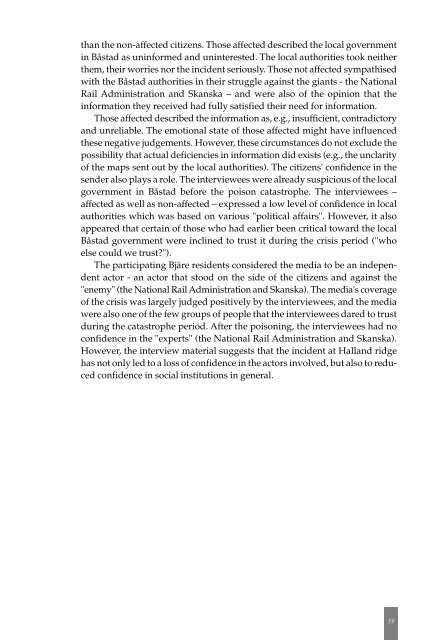Miljöhot och medborgaroro.pdf - Myndigheten för samhällsskydd ...
Miljöhot och medborgaroro.pdf - Myndigheten för samhällsskydd ...
Miljöhot och medborgaroro.pdf - Myndigheten för samhällsskydd ...
You also want an ePaper? Increase the reach of your titles
YUMPU automatically turns print PDFs into web optimized ePapers that Google loves.
than the non-affected citizens. Those affected described the local government<br />
in Båstad as uninformed and uninterested. The local authorities took neither<br />
them, their worries nor the incident seriously. Those not affected sympathised<br />
with the Båstad authorities in their struggle against the giants - the National<br />
Rail Administration and Skanska – and were also of the opinion that the<br />
information they received had fully satisfied their need for information.<br />
Those affected described the information as, e.g., insufficient, contradictory<br />
and unreliable. The emotional state of those affected might have influenced<br />
these negative judgements. However, these circumstances do not exclude the<br />
possibility that actual deficiencies in information did exists (e.g., the unclarity<br />
of the maps sent out by the local authorities). The citizens' confidence in the<br />
sender also plays a role. The interviewees were already suspicious of the local<br />
government in Båstad before the poison catastrophe. The interviewees –<br />
affected as well as non-affected – expressed a low level of confidence in local<br />
authorities which was based on various "political affairs". However, it also<br />
appeared that certain of those who had earlier been critical toward the local<br />
Båstad government were inclined to trust it during the crisis period ("who<br />
else could we trust?").<br />
The participating Bjäre residents considered the media to be an independent<br />
actor - an actor that stood on the side of the citizens and against the<br />
"enemy" (the National Rail Administration and Skanska). The media's coverage<br />
of the crisis was largely judged positively by the interviewees, and the media<br />
were also one of the few groups of people that the interviewees dared to trust<br />
during the catastrophe period. After the poisoning, the interviewees had no<br />
confidence in the "experts" (the National Rail Administration and Skanska).<br />
However, the interview material suggests that the incident at Halland ridge<br />
has not only led to a loss of confidence in the actors involved, but also to reduced<br />
confidence in social institutions in general.<br />
59

















